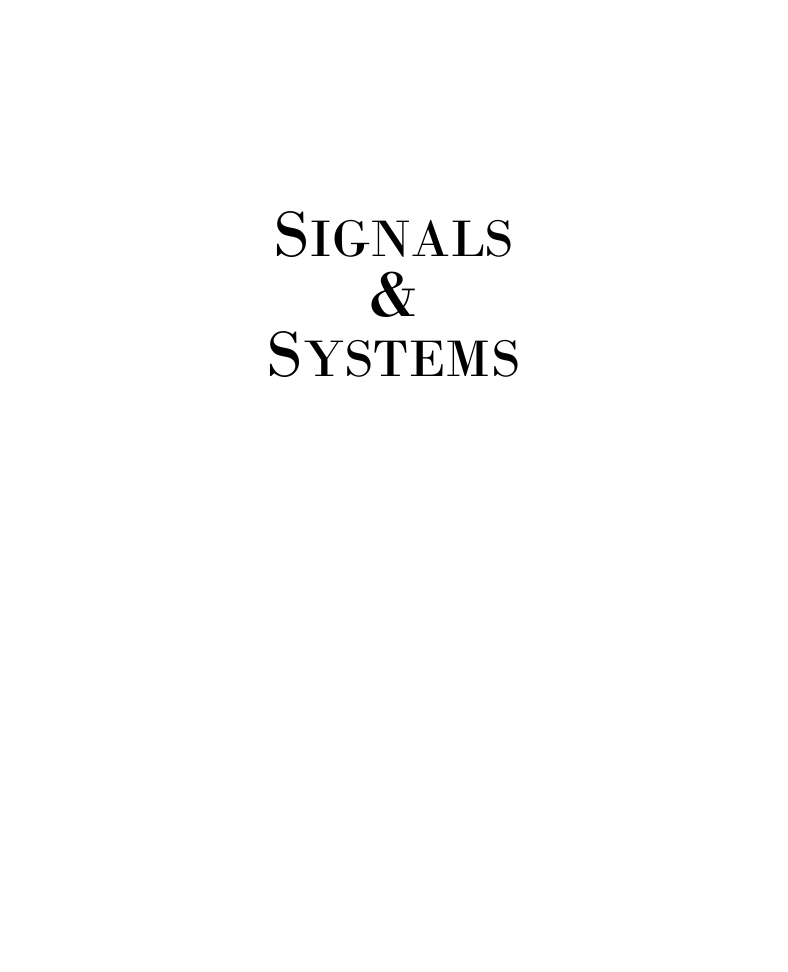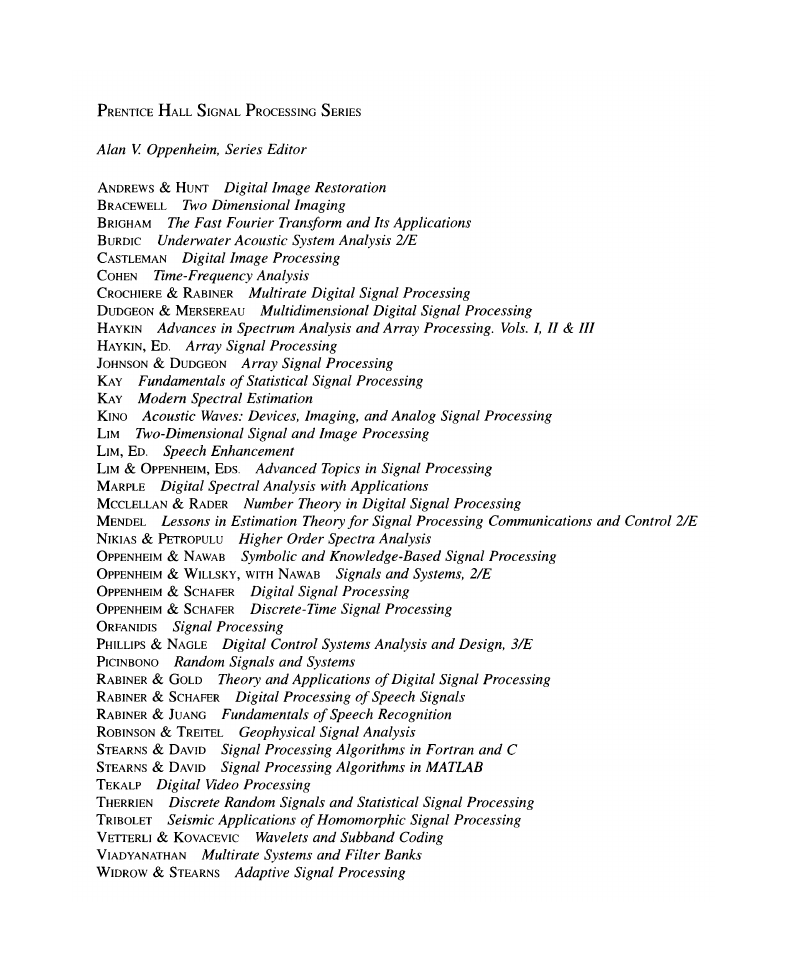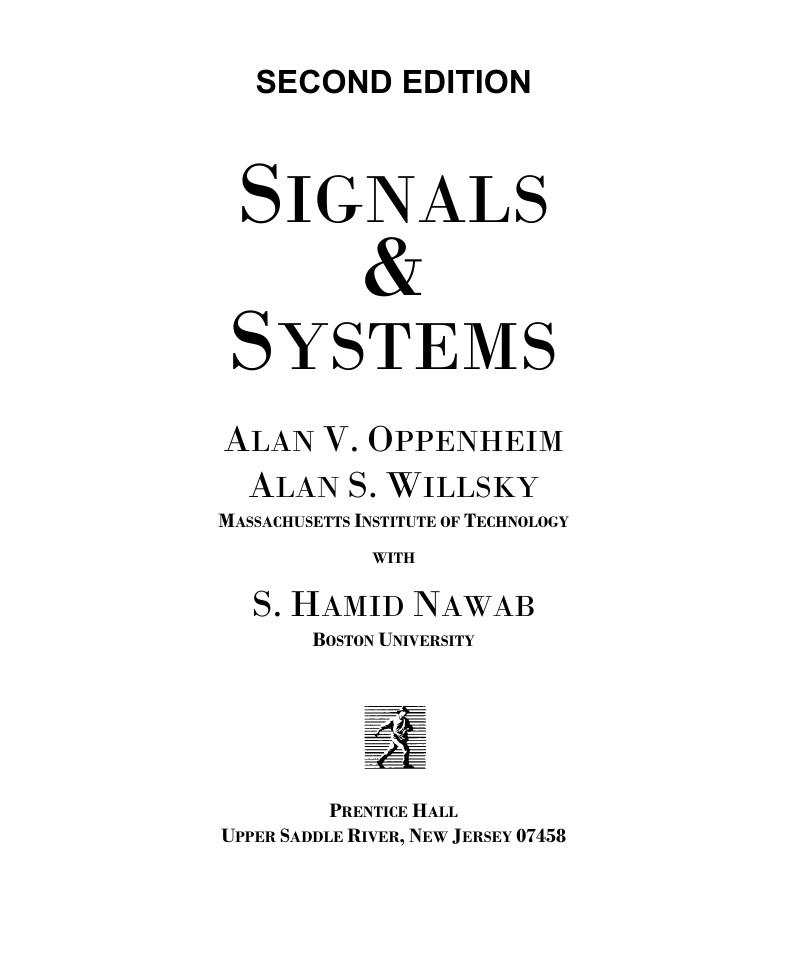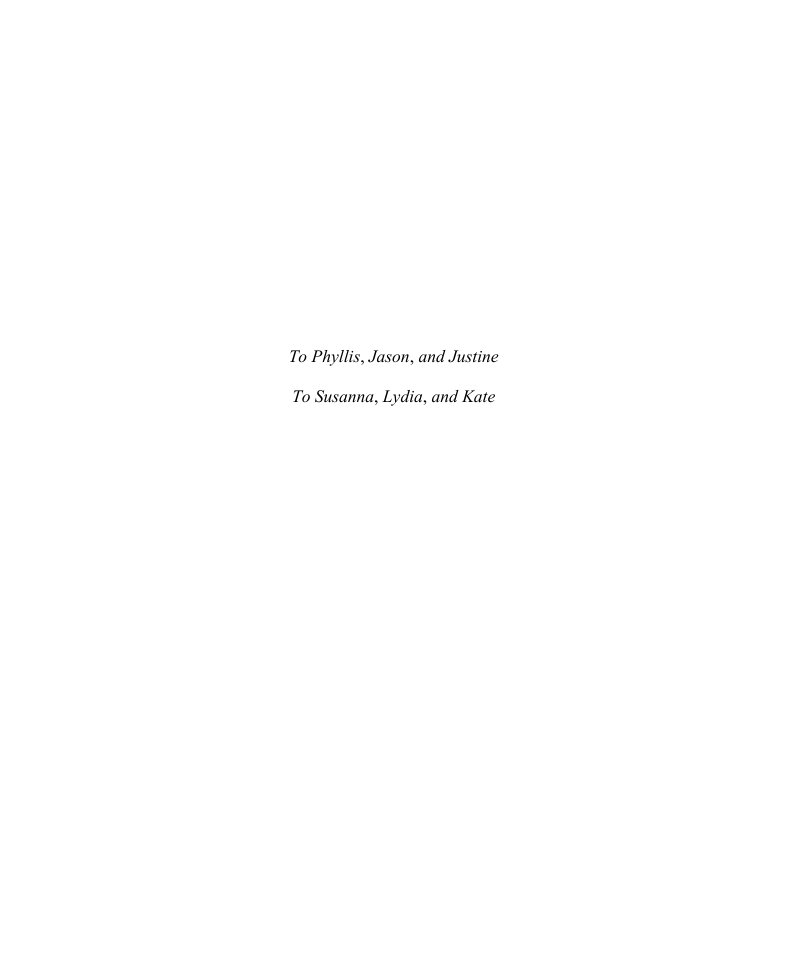Cover
Contents
Preface
Acknowledgements
Foreword
1 Signals and Systems
1.0 Introduction
1.1 Continuous-Time and Discrete-Time Signals
1.2 Transformations of the Independent Variable
1.3 Exponential and Sinusoidal Signals
1.4 The Unit Impulse and Unit Step Functions
1.5 Continuous-Time and Discrete-Time Systems
1.6 Basic System Properties
1.7 Summary
Problems
2 Linear Time-Invariant Systems
2.0 Introduction
2.1 Discrete-Time LTI Systems: The Convolution Sum
2.2 Continuous-Time LTI Systems: The Convolution Integral
2.3 Properties of Linear Time-Invariant Systems
2.4 Causal LTI Systems Described by Differential and Difference Equations
2.5 Singularity Functions
2.6 Summary
Problems
3 Fourier Series Representation of Periodic Signals
3.0 Introduction
3.1 A Historical Perspective
3.2 The Response of LTI Systems to Complex Exponentials
3.3 Fourier Series Representation of Continuous-Time Periodic Signals
3.4 Convergence of the Fourier Series
3.5 Properties of Continuous-Time Fourier Series
3.6 Fourier Series Representation of Discrete-Time Periodic Signals
3.7 Properties of Discrete-Time Fourier Series
3.8 Fourier Series and LTI Systems
3.9 Filtering
3.10 Examples of Continuous-Time Filters Described by Differential Equations
3.11 Examples of Discrete-Time Filters Described by Difference Equations
3.12 Summary
Problems
4 The Continuous-Time Fourier Transform
4.0 Introduction
4.1 Representation of Aperiodic Signals: The Continuous-Time Fourier Transform
4.2 The Fourier Transform for Periodic Signals
4.3 Properties of the Continuous-Time Fourier Transform
4.4 The Convolution Property
4.5 The Multiplication Property
4.6 Tables of Fourier Properties and of Basic Fourier Transform Pairs
4.7 Systems Characterized by Linear Constant-Coefficient Differential Equations
4.8 Summary
Problems
5 The Discrete-Time Fourier Transform
5.0 Introduction
5.1 Representation of Aperiodic Signals: The Discrete-Time Fourier Transform
5.2 The Fourier Transform for Periodic Signals
5.3 Properties of the Discrete-Time Fourier Transform
5.4 The Convolution Property
5.5 The Multiplication Property
5.6 Tables of Fourier Transform Properties and Basic Fourier Transform Pairs
5.7 Duality
5.8 Systems Characterized by Linear Constant-Coefficient Difference Equations
5.9 Summary
Problems
6 Time and Frequency Characterization of Signals and Systems
6.0 Introduction
6.1 The Magnitude-Phase Representation of the Fourier Transform
6.2 The Magnitude-Phase Representation of the Frequency Response of LTI Systems
6.3 Time-Domain Properties of Ideal Frequency-Selective Filters
6.4 Time-Domain and Frequency-Domain Aspects of Nonideal Filters
6.5 First-Order and Second-Order Continuous-Time Systems
6.6 First-Order and Second-Order Discrete-Time Systems
6.7 Examples of Time- and Frequency-Domain Analysis of Systems
6.8 Summary
Problems
7 Sampling
7.0 Introduction
7.1 Representation of a Continuous-Time Signal by Its Samples: The Sampling Theorem
7.2 Reconstruction of a Signal from Its Samples Using Interpolation
7.3 The Effect of Undersampling: Aliasing
7.4 Discrete-Time Processing of Continuous-Time Signals
7.5 Sampling of Discrete-Time Signals
7.6 Summary
Problems
8 Communication Systems
8.0 Introduction
8.1 Complex Exponential and Sinusoidal Amplitude Modulation
8.2 Demodulation for Sinusoidal AM
8.3 Frequency-Division Multiplexing
8.4 Single-Sideband Sinusoidal Amplitude Modulation
8.5 Amplitude Modulation with a Pulse-Train Carrier
8.6 Pulse-Amplitude Modulation
8.7 Sinusoidal Frequency Modulation
8.8 Discrete-Time Modulation
8.9 Summary
Problems
9 The Laplace Transform
9.0 Introduction
9.1 The Laplace Transform
9.2 The Region of Convergence for Laplace Transforms
9.3 The Inverse Laplace Transform
9.4 Geometric Evaluation of the Fourier Transform from the Pole-Zero Plot
9.5 Properties of the Laplace Transform
9.6 Some Laplace Transform Pairs
9.7 Analysis and Characterization of LTI Systems Using the Laplace Transform
9.8 System Function Algebra and Block Diagram Representations
9.9 The Unilateral Laplace Transform
9.10 Summary
Problems
10 The z-Transform
10.0 Introduction
10.1 The z-Transform
10.2 The Region of Convergence for the z-Transform
10.3 The Inverse z-Transform
10.4 Geometric Evaluation of the Fourier Transform from the Pole-Zero Plot
10.5 Properties of the z-Transform
10.6 Some Common z-Transform Pairs
10.7 Analysis and Characterization of LTI Systems Using z-Transforms
10.8 System Function Algebra and Block Diagram Representations
10.9 The Unilateral z-Transform
10.10 Problems
Problems
11 Linear Feedback Systems
11.0 Introduction
11.1 Linear Feedback Systems
11.2 Some Applications and Consequences of Feedback
11.3 Root-Locus Analysis of Linear Feedback Systems
11.4 The Nyquist Stability Criterion
11.5 Gain and Phase Margins
11.6 Summary
Problems
Appendix: Partial-Fraction Expansion
Bibliography
Answers
Index
















 2023年江西萍乡中考道德与法治真题及答案.doc
2023年江西萍乡中考道德与法治真题及答案.doc 2012年重庆南川中考生物真题及答案.doc
2012年重庆南川中考生物真题及答案.doc 2013年江西师范大学地理学综合及文艺理论基础考研真题.doc
2013年江西师范大学地理学综合及文艺理论基础考研真题.doc 2020年四川甘孜小升初语文真题及答案I卷.doc
2020年四川甘孜小升初语文真题及答案I卷.doc 2020年注册岩土工程师专业基础考试真题及答案.doc
2020年注册岩土工程师专业基础考试真题及答案.doc 2023-2024学年福建省厦门市九年级上学期数学月考试题及答案.doc
2023-2024学年福建省厦门市九年级上学期数学月考试题及答案.doc 2021-2022学年辽宁省沈阳市大东区九年级上学期语文期末试题及答案.doc
2021-2022学年辽宁省沈阳市大东区九年级上学期语文期末试题及答案.doc 2022-2023学年北京东城区初三第一学期物理期末试卷及答案.doc
2022-2023学年北京东城区初三第一学期物理期末试卷及答案.doc 2018上半年江西教师资格初中地理学科知识与教学能力真题及答案.doc
2018上半年江西教师资格初中地理学科知识与教学能力真题及答案.doc 2012年河北国家公务员申论考试真题及答案-省级.doc
2012年河北国家公务员申论考试真题及答案-省级.doc 2020-2021学年江苏省扬州市江都区邵樊片九年级上学期数学第一次质量检测试题及答案.doc
2020-2021学年江苏省扬州市江都区邵樊片九年级上学期数学第一次质量检测试题及答案.doc 2022下半年黑龙江教师资格证中学综合素质真题及答案.doc
2022下半年黑龙江教师资格证中学综合素质真题及答案.doc